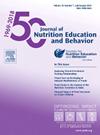“我能吃什么?”美国印第安人和阿拉斯加土著成人2型糖尿病患者的健康选择:糖尿病营养教育项目随机候补对照试验的结果
IF 2.3
3区 医学
Q2 EDUCATION, SCIENTIFIC DISCIPLINES
引用次数: 0
摘要
目的:评价“我能吃什么?”美国印第安人和阿拉斯加原住民成人2型糖尿病(AI/AN WCIE)干预的健康选择设计:试点随机候补对照试验。通过糖尿病登记处招募,随机分为立即干预组(n = 35)或候补对照组(n = 25)。直接组在随机分组后立即开始上课;候补组在随机分组后3个月开始上课。设置:2021年,课程由注册营养师在全国5个基于保留地或城市部落间临床站点同步在线教授。参与者:患有2型糖尿病的美国印第安人和阿拉斯加土著成年人(n = 60)。干预:AI/AN WCIE课程的主题包括:糖尿病餐盘,含糖饮料,减少钠,增加健康传统本地食品的消费。课堂活动包括教学、动手互动学习、体育活动、用心饮食和目标设定。主要结局指标:糖尿病营养自我效能、行为和临床指标。分析:线性混合模型检查随机分组从基线到1个月和3个月的结果变化。到3个月时,立即干预的参与者完成了课程;等候名单控制组还没有开始干预。结果:3个月后,立即干预组患者使用糖尿病平板的置信度(β = 0.80[95%置信区间(CI), 0.56-1.03], P < 0.001)和健康营养行为(β = 0.88 [95% CI, 0.57-1.19], P = 0.004)均有显著改善,而候补对照组无显著改善;即刻干预组在健康营养选择方面的信心(β = 0.65 [95% CI, 0.43-0.88], P = 0.02)显著高于候补对照组。临床结果未发现明显变化。结论:AI/AN WCIE项目提高了2型糖尿病成年人的自我效能感和健康营养选择。本文章由计算机程序翻译,如有差异,请以英文原文为准。
“What Can I Eat?” Healthy Choices for American Indian and Alaska Native Adults With Type 2 Diabetes: Outcomes From a Randomized Waitlist-Controlled Trial of a Diabetes Nutrition Education Program
Objective
To evaluate the “What Can I Eat?”: Healthy Choices for American Indian and Alaska Native Adults With Type 2 Diabetes (AI/AN WCIE) intervention.
Design
Pilot randomized waitlist-controlled trial. Recruitment through diabetes registries and randomized to either the immediate intervention (n = 35) or waitlist control group (n = 25). Immediate arm started classes immediately on randomization; waitlist arm started classes 3 months after randomization.
Setting
Classes were taught synchronously online by registered dietitian nutritionists at 5 reservation-based or urban intertribal clinical sites nationwide in 2021.
Participants
American Indian and Alaska Native adults with type 2 diabetes (n = 60).
Intervention
Topics in AI/AN WCIE classes include: the Diabetes Plate, sugar-sweetened beverages, decreasing sodium, increasing consumption of healthful traditional Native foods. Class activities included didactic sessions, hands-on interactive learning, physical activity, mindful eating, and goal setting.
Main outcome measure
Diabetes nutrition self-efficacy, behavior, and clinical measures.
Analysis
Linear mixed models examined change in outcomes from baseline to 1 month and 3 months by randomization group. By 3 months, immediate intervention participants had completed the classes; the waitlist control group had not yet begun the intervention.
Results
After 3 months, confidence in using the Diabetes Plate (β = 0.80 [95% confidence interval (CI), 0.56–1.03], P < 0.001) and healthy nutrition behavior (β = 0.88 [95% CI, 0.57–1.19], P = 0.004) improved significantly in the immediate intervention group but not in the waitlist control group; confidence in making healthy nutrition choices (β = 0.65 [95% CI, 0.43–0.88], P = 0.02) improved significantly more in the immediate intervention group than in the waitlist control group. No significant changes were identified in clinical outcomes.
Conclusions
The AI/AN WCIE program enhanced self-efficacy and healthful nutrition choices among adults with type 2 diabetes.
求助全文
通过发布文献求助,成功后即可免费获取论文全文。
去求助
来源期刊
CiteScore
4.20
自引率
11.50%
发文量
379
审稿时长
44 days
期刊介绍:
The Journal of Nutrition Education and Behavior (JNEB), the official journal of the Society for Nutrition Education and Behavior, is a refereed, scientific periodical that serves as a global resource for all professionals with an interest in nutrition education; nutrition and physical activity behavior theories and intervention outcomes; complementary and alternative medicine related to nutrition behaviors; food environment; food, nutrition, and physical activity communication strategies including technology; nutrition-related economics; food safety education; and scholarship of learning related to these areas.
The purpose of JNEB is to document and disseminate original research and emerging issues and practices relevant to these areas worldwide. The Journal of Nutrition Education and Behavior welcomes evidence-based manuscripts that provide new insights and useful findings related to nutrition education research, practice and policy. The content areas of JNEB reflect the diverse interests in nutrition and physical activity related to public health, nutritional sciences, education, behavioral economics, family and consumer sciences, and eHealth, including the interests of community-based nutrition-practitioners. As the Society''s official journal, JNEB also includes policy statements, issue perspectives, position papers, and member communications.

 求助内容:
求助内容: 应助结果提醒方式:
应助结果提醒方式:


